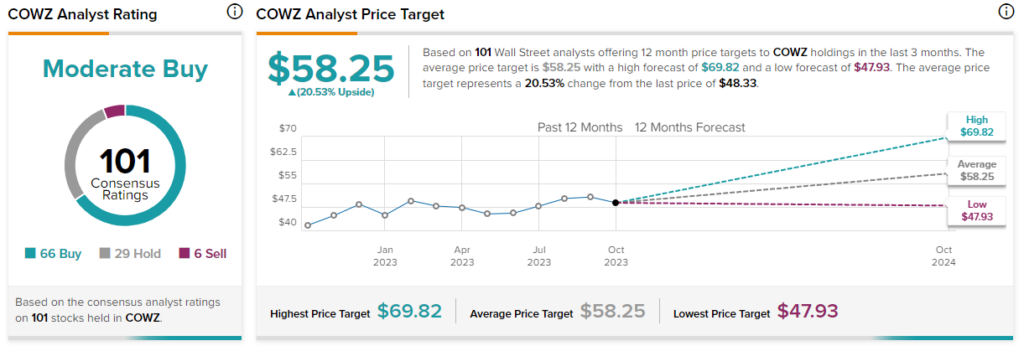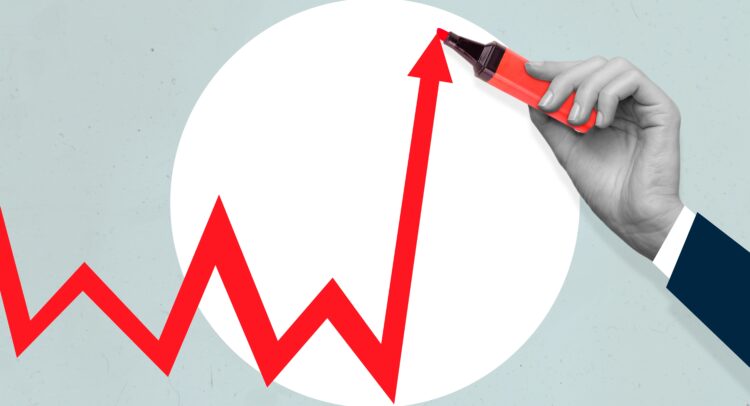The market is chock full of ETFs that focus on growth or value, and there’s no shortage of dividend ETFs either. Here are two ETFs that stand out by employing differentiated strategies and focusing on unique metrics — the Pacer US Cash Cows 100 ETF (BATS:COWZ) and the Cambria Shareholder Yield ETF (BATS:SYLD). Beyond their unique strategies, these two ETFs also stand out for the scorching returns they have put up in recent times.
Claim 70% Off TipRanks This Holiday Season
- Unlock hedge-fund level data and powerful investing tools for smarter, sharper decisions
- Stay ahead of the market with the latest news and analysis and maximize your portfolio's potential
Over three-year timeframes, COWZ has returned 23.8% on an annualized basis (as of June 31, 2023), while SYLD has returned 24% (as of August 31, 2023). Let’s learn more about the differentiated strategies that these ETFs employ and the results that they’ve generated.
Pacer US Cash Cows 100 ETF (COWZ)
So what is the strategy that makes COWZ stand out in the crowd? The fund places a unique focus on free cash flow yield. The fund’s sponsor, Pacer, explains that free cash flow “is the cash remaining after a company has paid expenses, interest, taxes, and long-term investments. It can be used to buy back stock, pay dividends, or participate in mergers and acquisitions.”
Companies that convert a large amount of revenue to free cash flow are likely operating efficiently and firing on all cylinders. Free cash flow yield is thus the free cash flow divided by the company’s enterprise value. Companies with a high free cash flow yield can be viewed as undervalued.
To choose the companies it invests in, COWZ starts out with the Russell 1000 Index and screens for the 100 companies with the highest free cash flow yields. It then invests in these companies and weights them by the highest free cash flow over the trailing 12 months.
This process is beneficial in that it gave the fund’s holdings a low price-to-earnings ratio of 6.6 and a high free cash flow yield of 9.7%, as of June 2023, versus a much more expensive average price-to-earnings multiple of 22.8 for the Russell 1000 Index and a much lower 3.1% free cash flow yield.
The process seems like an effective way to screen for efficient companies that are generating free cash flow and trading at a discount to the broader market. So what kind of portfolio does it create?
COWZ’s Holdings
COWZ has a diversified portfolio of 100 stocks, and its top 10 holdings make up just 21.1% of its portfolio. Below, you can check out an overview of the COWZ ETF’s top 10 holdings.

As you can see, the fund owns plenty of names in the energy sector, like Valero Energy, Marathon Petroleum, ExxonMobil, Chevron, Occidental Petroleum, and Diamondback Energy. These companies have been generating excess free cash flow based on rising oil prices, and they are returning plenty of this free cash flow to shareholders in the form of dividends and share buybacks.
If you are worried that the fund skews too heavily towards energy, remember that it rebalances on a quarterly basis, so it will soon trim the position size of some of these winners to stay diversified.
The healthcare sector is also prominently represented through the likes of CVS Health, McKesson, and AbbVie.
Solid Returns Over Time
This focus on companies with high free cash flow yields has produced banner returns over time. Over the past three years, this underrated ETF has returned 23.8% on an annualized basis, and over the past five years, it has generated an annualized return of 12.3%, about in line with the broader market but still an excellent double-digit annualized return.
COWZ sports an expense ratio of 0.49%, meaning that an investor allocating $10,000 into the fund would pay $49 in fees over the course of the year. As an added bonus, COWZ features a dividend yield of 2.1%.
Is COWZ Stock a Buy, According to Analysts?
Analysts take a favorable view of COWZ, giving it a Moderate Buy consensus rating based on 67 Buys, 28 Holds, and six Sell ratings assigned over the past three months. The average COWZ stock price target of $58.45 implies upside potential of 20.5%.

One interesting thing about COWZ is that it boasts an Outperform Smart Score of 8 out of 10. The Smart Score is a proprietary quantitative stock scoring system created by TipRanks. It gives stocks a score from 1 to 10 based on eight market key factors. A score of 8 out of 10 or higher indicates the potential for a stock to outperform the broader market.
Cambria Shareholder Yield ETF (SYLD)
While COWZ focuses on free cash flow yield, SYLD focuses on a different type of yield — shareholder yield. Shareholder yield is the money that shareholders receive from an investment in the form of dividends, share repurchases, and debt paydowns. Shareholder yield is calculated by dividing the total of the money returned using these avenues by a stock’s market cap.
Like COWZ, SYLD uses a screening process to select a portfolio of stocks with high shareholder yields. It starts with a universe of 3,000 stocks and then selects the top 20% of these stocks based on shareholder yield. It then evaluates these stocks on a number of valuation metrics and chooses the 100 stocks that “exhibit, in aggregate, the best combination of shareholder yield characteristics and value metrics,” according to Cambria.
SYLD’s Holdings
Like COWZ, SYLD rebalances on a quarterly basis and equally weights its 100 equity holdings. Its top 10 holdings make up just 15.7% of the fund.
Below, you’ll find an overview of SYLD’s top 10 holdings.

This focus on shareholder yield creates a portfolio that has a bit in common with the COWZ ETF’s portfolio. Like COWZ, SYLD owns plenty of energy stocks like Chevron, ExxonMobil, and ConocoPhillips.
Additionally, SYLD owns a multitude of financials like Ameriprise Financial, Assured Guaranty, and AFLAC. It also owns a number of auto and truck retailers like Penske Automotive and Auto Nation, plus retailer Dillard’s.
Stellar Past Performance
Like COWZ, SYLD has been a star performer in recent years, posting a three-year annualized return of 24.0%, blowing away the returns of the broader market. Over the past five and 10 years, SYLD’s returns have been more in line with the broader market, with five- and 10-year annualized returns of 12.1% and 12.5%, respectively.
SYLD is also a dividend payer, and it currently yields 2.5%.
The only negative about SYLD is that it has a fairly high expense ratio of 0.59%, meaning that an investor putting $10,000 into the fund would pay $59 in fees in year one. However, SYLD is actively managed, so it is going to be more expensive than an index fund, and the ETF has “walked the walk” and put up the types of returns that justify a high fee over the past three years.
Is SYLD ETF a Buy, According to Analysts?
Analysts give SYLD a Moderate Buy consensus rating based on 67 Buy ratings, 29 Hold ratings, and six Sell ratings assigned within the past three months. The average SYLD stock price target of $70.75 implies upside potential of 17.7%.

A Pair of Great ETFs
These are two unique funds that have utilized unique strategies to generate excellent returns for their shareholders. By focusing on free cash flow yield and shareholder yield, respectively, COWZ and SYLD have created excellent portfolios of companies that operate efficiently and return plenty of capital to shareholders. This combination of differentiated strategy and excellent returns means that both COWZ and SYLD stand out in a crowded ETF field, and both look like attractive options for investors.
















